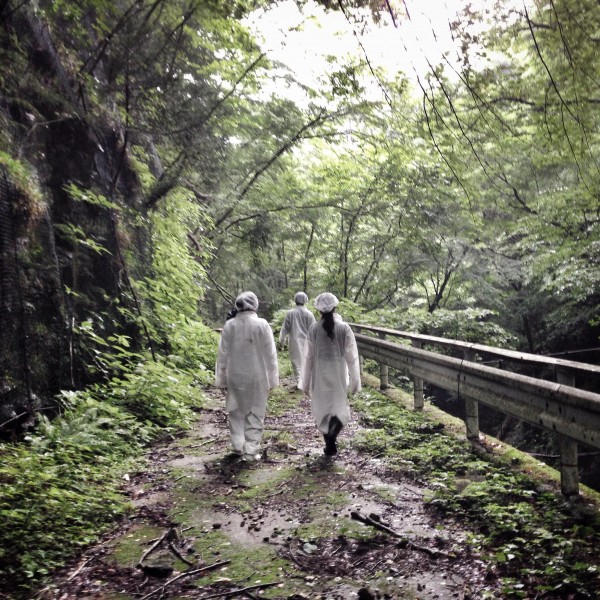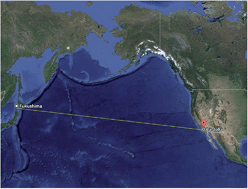Monitoring the environmental effects of major nuclear incidents is an essential but complex undertaking. The use of the iodine-129 isotope as a tracer for detecting nuclear pollution in the environment has been widely established. The present study, by researchers from the Horia Hulubei National Institute for Physics and Engineering in Bucharest, Romania, applies this method to assess the impact of radioactive releases after the 2011 Fukushima accident in Japan.
On March 11th 2011, a magnitude 9.0 earthquake stuck 130 km off the east coast of Japan, causing a 15 m tsunami, which inundated about 560 sq km of land. In addition to causing a death toll of over 19,000 and destroying or damaging over a million coastal buildings, this tsunami also disabled the power supply and cooling of three nuclear reactors at the Fukushima Daiichi plant, causing a major nuclear accident. Over 100,000 people were evacuated from the area, and an exclusion zone of 20 km around the plant was established. A comprehensive account of the cause and effects of this Fukushima incident is provided by the World Nuclear Association.

Fukushima exclusion zone. Source: Thom Davies (http://thomdavies.com/tag/fukushima/)
In the wake of the disaster, much research and discussion has been undertaken to assess its environmental impact and the future safety of nuclear energy generation. Experts estimate that the Fukushima incident caused the largest ever direct release of radioactive material, such as iodine-129 and caesium-137 isotopes into the Pacific Ocean. The nature and extent of how this nuclear material is transported and dispersed in the ocean requires careful consideration, in order to assess the full environmental impact of the accident.
There is considerable uncertainty regarding the eastward migration of this radioactive plume in the Pacific Ocean and efforts to locate and characterise its position and movement have been unsuccessful so far. Iodine-129 displays a long residence time (half-life of 15.7 million years) and relatively low bioavailability. In very small quantities, it can act as an effective sensitive tracer of the radioactive plume in ocean waters. As a consequence, this study by C. Stan-Sion and co-workers used iodine-129 to determine the nuclear plume impact on the West Coast of the USA, roughly two years after the Fukushima incident.
For this research, ocean water samples were collected in La Jolla, San Diego, California on the West Coast of the USA (approx. 8770 km east of Fukushima) between April and July of 2013. Accelerator Mass Spectrometry (AMS) was used to determine the iodine-129/ iodine-127 ratio in the collected samples. Its very high sensitivity for measuring such isotopes was the main reason why this analytical method was chosen.
The results showed two sudden increases of the iodine-129/ iodine-127 isotopic concentration in the ocean water during late spring of 2013. The isotopic iodine-129/ iodine-127 ratio was more than a 2.5 factor higher in USA West Coast water samples, compared with those measured 40 km offshore of Fukushima immediately after the accident.
Also, compared with the pre-Fukushima background values, the results of this study show an isotopic ratio of about two orders of magnitude higher. Based on these results, the authors calculated that the plume travelled with an average speed of approximately 12 cm s-1, which is consistent with the zonal current speed in the Pacific Ocean.
This investigation therefore demonstrates how the iodine-129/ iodine-127 isotopic ratios can be used to assess the impact of a certain nuclear accident in locations far removed from the accident site. Finally, the authors also coupled their iodine-129 results with the results of the Ka’imikai-O-Kanaloa international expedition in June 2011 to assess the activity of other radioactive isotopes such as hydrogen-3 and caesium-137, and the activity of these radio-isotopes were compliant with the international regulatory limits.
To access the full article, download a copy for free* by clicking the link below.
AMS analyses of I-129 from the Fukushima Daiichi nuclear accident in the Pacific Ocean waters of the Coast La Jolla – San Diego, USA
C. Stan-Sion, M. Enachescu and A. R. Petre
Environ. Sci.: Processes Impacts, 2015, 17, 932-938
DOI: 10.1039/c5em00124b
—————-
Ian Keyte is a Doctoral Researcher at the University of Birmingham. His research focuses on the sources, behavior and fate of polycyclic aromatic hydrocarbons (PAHs) in the urban atmosphere.
—————-
* Access is free until 21/06/2015 through a registered RSC account.












